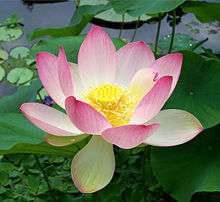Salt evaporation pond
Salt evaporation ponds, also called salterns, salt works or salt pans, are shallow artificial ponds designed to extract salts from sea water or other brines. The seawater or brine is fed into large ponds and water is drawn out through natural evaporation which allows the salt to be subsequently harvested. The ponds also provide a productive resting and feeding ground for many species of waterbirds, which may include endangered species.[1] The ponds are commonly separated by levees.
Natural salt pans are geological formations that are also created by water evaporating and leaving behind salts.
Algae and colour of evaporation ponds
Due to variable algal concentrations, vivid colors – from pale green to bright red – are created in the evaporation ponds. The color indicates the salinity of the ponds. Microorganisms change their hues as the salinity of the pond increases. In low- to mid-salinity ponds, green algae such as Dunaliella salina are predominant, although these algae can also take on an orange hue. In middle- to high-salinity ponds, Halobacteria, which is actually a group of halophilic Archaea (sometimes called Haloarchaea), shift the colour to pink, red and orange. Other bacteria such as Stichococcus also contribute tints.
Notable salt ponds
Notable salt ponds include:
- the Salterns of Guérande, in Brittany, France, the last artisanal salt production in France. The salt produced in the salterns are a Protected geographical indication in Europe
- the Salinas de Chiclana, on the southern edge of the Bay of Cádiz in Chiclana de la Frontera, Spain
- the Sečovlje and Strunjan salt ponds on the northern edge of the Adriatic Sea in Slovenia,
- the San Francisco Bay salt ponds in the United States, operated by Cargill,[2][3][4][5] including Charleston Slough
- the Dead Sea salt ponds in the West Bank, Israel and Jordan
- the Port Hedland, Dampier, Lake McLeod, Useless Loop and Onslow salt ponds in Western Australia
- Yellow Walls, Malahide, Ireland; active from 1770 to 1837.[6]
Until World War II, salt was extracted from sea water in a unique way in Egypt near Alexandria.[7] Posts were set out on the salt pans and covered with several feet of sea water. In time the sea water evaporated, leaving the salt behind on the post, where it was easier to harvest.
Salt pans
Salt pans are shallow open, often metal, pans used to evaporate brine for the production of salts. They are usually found close to the source of the salt. For example, pans used in the solar evaporation of salt from sea water are usually found on the coast, while those used to extract salt from solution-mined brine will be found near to the brine shaft. In this case, extra heat is often provided by lighting fires underneath.
.jpg) San Francisco Bay salt ponds
San Francisco Bay salt ponds
 Contemporary solar evaporation salt pans on the island of Lanzarote
Contemporary solar evaporation salt pans on the island of Lanzarote Solar evaporation ponds in the Atacama Desert
Solar evaporation ponds in the Atacama Desert- Solar evaporation ponds in the Salt Valley of Añana, Spain
 Solar evaporation ponds in the Salt Valley of Añana, Spain
Solar evaporation ponds in the Salt Valley of Añana, Spain
See also
References
- ↑ Athearn, Nicole D.; Takekawa, John Y.; and Shinn, Joel M. (2009) Avian response to early tidal salt marsh restoration at former commercial salt evaporation ponds in San Francisco Bay, California, USA, Natural Resources and Environmental Issues: Vol. 15, Article 14.
- ↑ Napa Salt Pond Complex, The Bay Institute
- ↑ Salt ponds, South San Francisco Bay, NASA Earth Observatory
- ↑ "NASA Helps Reclaim 15,100 Acres Of San Francisco Bay Salt Ponds". Space Daily. Moffett Field. July 14, 2003.
- ↑
- ↑ https://oldyellowwalls.org/the-salt-works/
- ↑ Salt, Grown On Sticks Harvested From Sea, Popular Science, March 1933
External links
| Wikimedia Commons has media related to: |
- NASA page on salt ponds
- Information on the San Francisco Bay salt ponds
- Interactive satellite view
- "Salt, Grown On Sticks Harvested From Sea" Popular Science, March 1933
